The SST Formation
December 20th, 2004
A Direct Snap Supplement to the Double Wing Offense
by Steve Popovich and Ted Seay
Introduction
The SST is a synthesis of the double and single wings and the shotgun. Simply put, we can run most of the double wing plays, with equal power, and still have a fairly strong, variable passing threat that doesn’t require play-action which is ineffective in situations where we must pass and everybody knows it.
The SST formation resembles the double wing and most of the runs are very obviously taken directly from that powerful running set but, as with a single wing attack, one player assumes the multiple rolls of passer and main runner on power plays and runs both wingback and fullback plays.
Although the SST does not “spread” the defense, as most shotgun formations like to do, veteran double wingers realize that there is more than one way to skin a cat. In youth football, most defensive coaches prefer to rely on pressure rather than coverage to defeat the pass. Spreading out five receivers, with minimal blocking, plays directly into their hands. Additionally, the SST offers a built in “Bunch” passing attack but also allows us to split out our best receiver, protect with eight or nine blockers, and simply chuck the ball to that excellent athlete. More often than not, that strategy is much more effective in late game situations than trying to give the quarterback many targets (and many potential moments of confusion and hesitation).
Because our quarterback sets his feet to pass, brings up the ball and looks downfield, we are, in a sense, using pass play-action to set up most of our base runs. Although our double tight, T-snap double wing has rarely been contained (we’ve led our 18-team league in points scored the last two years and have never finished lower than third with this offense), a good defensive scheme, combined with good athletes, can make our job difficult. Switching formations, especially to a very different flavor, can destroy the tidy program devised by the opponent. Doing so while still keeping the linemen’s assignments unchanged, while opening up the threat of a pass, and while putting the ball in the hands of our best athletes, just makes sense.
Base Set
The base SST set has two tight ends and two wings. Our quarterback is set at four yards deep directly behind center. Our top receiver is flanked to either side. Stances are a matter of choice. We prefer a two-point stance for all 11 players, adjusted to position requirements (i.e. the flanker may take a more open stance than the wings or linemen).

In the Gun Right formation (fig. 1), our fullback aligns as the left wing, our usual C-Back aligns as the flanker and the A-Back moves to the right wing (slot) with the quarterback dropping back. This is purely dependent on personnel choices and may be accomplished by, for instance, removing the fullback and replacing him with a kid who can catch, flanking the quarterback (if he happens to be a great receiver), moving the A-Back to quarterback (if he is a good passer and runner) and working from there. Ideally, the fewer changes in personnel, the better, but the point is to put the best kids at positions that fit their talents and abilities with as few changes in assignments as possible.
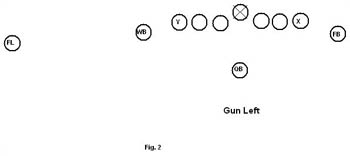
It may be necessary to flip-flop the backfield players when aligning in Gun Left (fig. 2), if your fullback-type is the only guy who can execute a good kickout block. Flipping tight ends may also be a good idea, since the X end is not used much as a receiver.
In most cases, the fullback goes in motion down the line toward the flanker-side and the quarterback will call for the ball as he passes the midline, but he may be motioned to any width desired or no motion may be called for.
The SST Running Game
The SST base runs are pure double wing; Toss, Wedge, G, Trap, Counter, Sweep. A single wing flavor can be added by motioning the fullback or wingback toward the quaterback (who can then execute spin plays) and, if a more complete conversion is desired, the flanker can remain inside as a single wing blocking back.
In any case, the blocking of the double wing plays can remain identical to that run from the T-snap set in nearly every case.
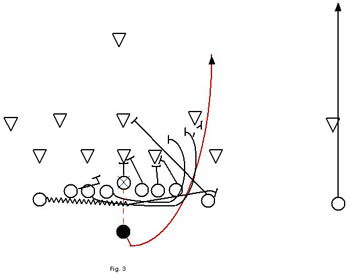
Our main power play is the off-tackle Toss play (88/99 Power or Super Power in the Wyatt system) but, of course, there’s no toss. The quarterback simply fields the direct snap, sets his feet to pass, brings up the ball and looks downfield for a second. This allows the pulling linemen to get ahead of him. He then tucks the ball and runs just like the wingback would on the normal play. It doesn’t matter if the quarterback is left-handed or right-handed; he can set as he would on any pass and then fall into the flow of the play. (Figure 3.)
8 Super Power
Against certain defenses, we might want to run our G plays. They begin like our power play but hit inside of the C gap with the fullback and back side guard leading through the hole. (Figure 5)
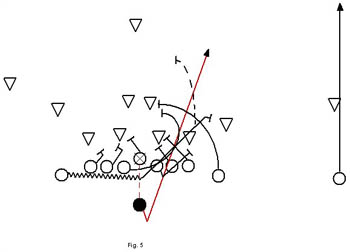
6 G
We run our great trap as a draw, which is not as deceptive as the normal fullback trap but can still be effective in the right situation. In Fig. 6, the Trap is shown with longer motion by the fullback than typical, giving the defense more of a pass read.
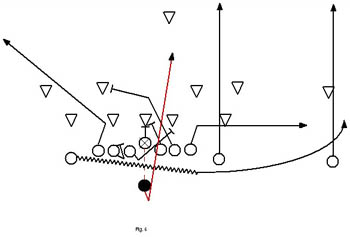
Trap Draw
Obviously, misdirection suffers in this set, but can be compensated for by running the standard double wing inside counter. Shown in Fig. 7, the fullback blocks out on the defensive end but, if that man is not a problem, the fullback can stop and lead back on the counter, making it a much more powerful play (Fig. eight).

Counter
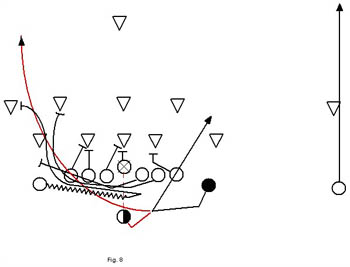
Counter - Fullback Lead
Although it is technically a pass, we can also run the counter play, without motion or with extended motion, as a shovel pass. This is one of my favorite plays from double wing spread and can be incredibly effective if either the back side cornerback or outside linebacker goes in motion with the fullback. (Figure 9.)
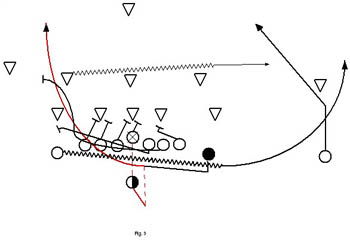
Counter - Shovel Pass
The SST Passing Game
The pass route packages below form a core dropback passing attack for the SST. Although many more pass plays can be added, it is better to perfect a few things than to run many fairly well. The same holds true with the play-action pass off of the Sweep run action.
With the exception of the Flood play-pass, the dropback passes can be blocked in an identical fashion. The fullback blocks the first rusher past the playside tackle. The line will block a lineman over them (outside shoulder to inside shoulder). The first lineman inside the playside tackle who has a “bubble” over him (i.e., no lineman, either a linebacker or nobody at all) will slide back side to block his inside gap with shoulders square to the line of scrimmage. The fullback must be aware of potential blitzers through the bubble, and must check the bubble for danger rushers on his way to block the end defender on the line of scrimmage.
In all the pass route packages, a primary and secondary read are given for the quarterback. There should never be a situation where the quarterback needs to take more than two reads before throwing the ball. If neither read is open, he should either tuck the ball and run, or else throw it away.

Y Stick
Wingback (A-Back) runs a quick Shoot route a yard deep, snapping his head around to look for the ball as soon as he breaks outside; playside tight end (Y) runs a Stick route, breaking outside at +6 yards, while the flanker (C-Back) runs a Go route straight downfield, looking for the ball over his inside shoulder.
Quarterback’s first read is the flanker — if he can run past coverage, throw him the ball. Otherwise, the quarterback checks down to the first underneath defender inside the playside cornerback. The quarterback wants to throw the Stick route to Y — the Shoot route to the A-Back becomes a reaction if the short defender takes the Stick route away. The back side tight end (X) can either stay in and block, or if the safety starts overplaying the Stick route, X can release on a quick Post route for a sure touchdown.
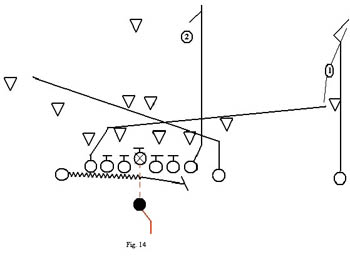
Kentucky Mesh
This pass route package releases four receivers, leaving six men to block. The quarterback needs to be aware he may get a backside rush with X releasing on a pass route.
The flanker/C-Back runs a deep Flag route, cutting at about 12 yards and looking for the ball over his outside shoulder right away. Both X and the wingback/A-Back run Shallow Cross routes, with the A-Back crossing high and X low (this will rub any man defender off X). Y runs a Middle Read route. He heads straight downfield looking for the nearest safety. If there are two he should split them, running right in between. If there are no safeties he continues straight downfield, looking for the ball over his inside shoulder. If there is a deep middle safety who loses ground to stay deeper than Y, he should hook back toward the quarterback at about +15 yards deep.
The quarterback looks first to the C-back’s Flag route, then down to X’s Shallow Cross. If both are covered, he goes to Y’s Middle Read route.
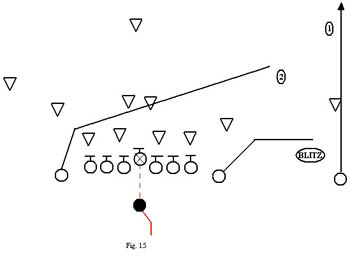
B Cross
Against some teams releasing four receivers on a regular basis will not be easy. Against those teams, B Cross is a good alternative to Kentucky Mesh. B now runs the Shallow Cross route. The quarterback reads the C-Back/flanker, the B-Back, and if necessary the A-Back/wingback. If the quarterback feels blitz pressure, he can throw right away to the A-Back’s Shoot route. With seven blockers, though, you should see too many blitz situations that you can’t handle.
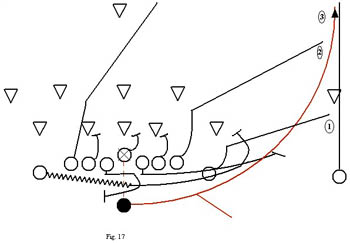
Flood
The guards cannot pull past the line of scrimmage in case the quarterback pulls up and passes. The blocks that Y, the A-Back/wingback and C-Back/flanker throw in a regular Sweep play become pass routes. The quarterback should look first for the quick Shoot route in the playside flat by the A-Back. If he is open, throw the ball. If not, look for the Flag route by Y. Finally, tucking the ball in case the defensive backs drop back to cover the pass routes is built into the play automatically.
For the full paper please click here.
The Wedge
December 13th, 2004
The wedge play and the series built from should be a very important cog is any single wing offenses playbook. When I first researched this offense and play four years ago, I thought it looked like a silly play. I decided to put it in anyway, as I came to the conclusion the coaches suggesting it had much more success and experience than I had. The wedge play is a very simple play that can be built into a very successful series and base offense out of the single wing and double wing formations.
Why Run It?
1) It can be run to a variety of ball carriers on any down and nearly any yardage situation at any spot on the field.
2) It sets up other plays in the series.
3) It can be a power play or a deception play (if you have a small ball carrier)
4) It is surprisingly deceptive
5) It can be used with both strong and weak players at several positions, and a great play to help you guys with minimum play rules.
6) It is very demoralizing to the other team.
7) Your kids will love it and it will end up being their favorite play.
8) When the defense sells out on the wedge or submarines, sets up other plays.
9) Linemen are interchangeable.
10) Backs are interchangeable (on base wedge), great way to get non ball carrier the ball.
11) It is our signature play.
Base Plays
1) Wedge
2) Wedge with Motion/Fake Tailback Spin
3) Fullback Full Spin, Blocking Back Wedge
4) Whacky Wedge (Blocking Back under Center)
5) Blocking Back Wedge (Fake Fumble)
6) Blocking Back Wedge (Fake Tailback Sweep Pass)
Complimentary Plays
1) Buck Wedge
2) Buck Wedge Pass
3) Buck Wedge Reverse
4) Buck Wedge Keep (Fullback Wedge Keep)
Teaching/Drilling the Wedge
Start with a set line with the probable positions, preferably two full lines one in front of the other facing the coach. Tight splits toe-to-toe, guards toes on heels of center.
Progression Drill
We are wedging at the strong guard, he is the point of attack. He always just steps directly forward with fists touching, flippers out at shoulder level, think like the blockers on your old electric football set.
1) From 2-point stance take first step with inside foot towards inside, putting it just behind and inside the outside foot of the man to his inside.
2) From 2-point stance same as above but add the shoulder goes to rib cage of inside player. Inside arm stays in, outside arm/hand goes to outside shoulder of the inside man you are pushing on. This outside arm to outside shoulder along with the leg drive create the push. On go, we slowly take that step to the inside looking for proper foot placement and shoulder to ribs along with outside arm/hand to outside shoulder. Make sure player is staying low and head is up. Ends will have to take more than 1 step to make a good fit, they must be quick.
3) Next progression, do it from a 3-point stance. One step to a good first step only. Again ends will have to take more than one step. Look to make sure we have a very tight fit and “V” look. Do it very slowly, then move up the pace.
4) Next progression, do a 3-point to a wedge fit and then freeze. Here we are looking for shoulder to rib cage, feet placement and hand placement. Make sure all the kids are frozen and you have a tight fit. The wedge has to be tight at its inception.
5) Next progression, do a 3-point. Once you have the tight fit, and have them freeze on it to check for a tight fit, have then take three steps forward on your count, slowly 1, 2, 3, making sure they stay together, strong guard leading. To start your counts will be very very slow. As they progress, make the counts quicker.
6) Next progression, speed up the counts, then get to ten pretty fast. It is never at a run, just quick and methodical. Make sure they stay low. Keep it together for 15 yards.
7) Next, put blocking shield dummy with coach at point of attack, providing resistance, remember your kids are pushing on each other to launch your strong guard into the secondary. They block none, they push on the inside guy next to them. Must stress that they can never break the wedge to block ANYONE.
8) Have the kids close their eyes tightly shut (except for strong guard), and run the entire progression until they can stay with each other against resistance for a ten count. They should be able to stay fit to their counterpart.
Troubleshooting
If your having a tough time keeping the wedge together, make sure you have quick enough kids on the ends, if not make a change. If they still can’t stay together start the drills with only wedging the strong guard with a player on both sides. When you get that down, keep adding players to both sides until all seven are there. I like to put two long dummies about 3 yards in front of the line, perpendicular and tighter than the formation by three feet on both sides. Run the drill and make sure you are getting enough compression to get through the dummies. It needs to look like a “V”. This drill must be done every day, as we found even though we ran the series very well, when we went away from it, the kids struggled with the play.
Backfield
Running the wedge takes a bit of getting used to, it is an art of sorts. It is NOT a dive play; it requires power, patience and acceleration. We start with the fullback getting the snap running right to the back of the strong guard and actually pushing on his back with the free arm with a pretty good shoulder lean. He must STAY IN THE WEDGE until it breaks up. That means no going around either end or looking for an off-tackle bubble. Stay in the wedge, keep your head up and keep your legs pumping and moving forward, until it breaks up, then sprint to daylight. Stay inside; do not run parallel, it either breaks right up the gut or at a very slight angle. Often the daylight does not appear until 10-15 yards downfield, stay in the wedge until you see the daylight, stay patient until then, just staying low and pushing forward. When feeling pressure, both hands over ball. Encourage your backs to think small, they need to stay very low, under the height of the linemen and keep their heads up. We stress to our ball carriers, if they do not stay in the wedge, they do not carry the ball, period. Natural inclination is to break it outside or look for the hole. In the wedge there is no hole, it opens up downfield.
Other Backs
If you have a fake, must carry it out convincingly, if not you do not play. We have to threaten the perimeter with the fakes to keep the ends and linebackers honest as well as the defensive backs. We found we averaged over 12 yards per carry with the motion and tailback half spin, threatening the perimeter versus 6.5 with the base wedge. Double wing would be faking with reverse action and motion to threaten the flanks. We also averaged over 20 yards per carry on the blocking block wedge with full spin fakes.
Many teams have their backs protect the perimeter with blocks, We have tried both and found it much more effective to threaten the perimeter with fakes or having them push on the backs of the tackles to get a bigger surge and create confusion as to who in the pile has the ball. Remember they cannot push on the back of the runner because it is a penalty. Review it and stress it. During our first entire season at 8-10 year old age group with over 275 wedge plays we were called for it once. At 13-14 year old level with about 150 wedge plays we were never called for it.
Notes
Make sure you tell the officials ahead of time that you run the wedge. Let them know that you know it is a penalty to push on the backs of the runner, you have taught your kids not to push on the back of the runner and they do not. Let them know that often the wedge breaks up past the line of scrimmage and please don’t blow a quick whistle as long as there is still movement. Also let them know that sometimes inadvertent whistles get blown on the play and that they need to make sure they see the player down before they blow the whistle, as you run lots of misdirection off the play. We have film of our blocking back tapping the official on the back in the end zone to hand him the ball, as the official is following our fullback.
In practice, you can’t really run the wedge against your own kids. It is very demoralizing and too much to ask, lots of kids will not be there the next day if you run it live. Run it on air or with a coach providing resistance at the point of attack.
If your opponent submarines (it is the ONLY way to defend the wedge), tell your kids not to get uptight about it. Have your kids keep their knees high and step on defenders. Most teams believe it or not never submarine. Many will put everyone up tight and have the linebackers moving toward the line of scrimmage at the snap. Some did 10 man lines (not for long) and many just yelled at their kids and got mad.
Our most successful strategy when the wedge was not working well has been to go to the buck wedge, off-tackle, sweep or buck wedge pass. We then go back to the wedge. We scored 3 or 4 times on the first play of the game running the “Wacky Wedge”. It only worked a few times before we went back to the base offense. This play also worked very well at the 11-12 year olds and 13-14 level out of our double wing formation. This is the play where we put our blocking back under center with his hands on the center’s hams. We line our fullback and tailback foot-to-foot with the fullback right behind center at about 2 yards, we have the center snap through the “quarterback’s” legs to our fullback who runs wedge. The tailback and “quarterback” run to right as an option look.
Be prepared to get a lot of funny looks from your parents and players when you start running this. You have to sell them on the play and rep the heck out of it. The reward will be on game days as you methodically crush down the field with one play, the next series scoring on the buck wedge, or buck wedge pass untouched. The other teams will be talking about your “middle play”, coaches will complain about it, opposing players will fear it and hate it. Your kids will love it after the initial discomfort.
Word to the wise, it needs to be repped 10 minutes every day, we were running it perfectly year one and got away from practicing it every day and it hurt us. Once we went back to every day, everything was fine. My personal fall teams at the 8-10 year old level have been 41-1 since we put in the offense and I have never coached the same team twice. This included big select teams, average or less B squads and even a weak tiny all rookie team. You do not need big kids.
Play Descriptions
We line up in a typical unbalanced single wing except we have our tailback and fullback at 2 to 2-1/2 yards away. It is much more deceptive this way and a much safer snap. We also have our center snap low. The fullback, tailback and blocking back must have the tips of their fingers actually touching the ground. This makes the snap harder to see and gives the center a good low target.
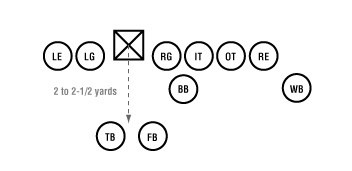
Snap to fullback. He puts his left hand in the right guard’s back, the tailback runs sweep right, dipping inside shoulder, the blocking back pushes on the center’s back, and the wingback pushes on the outside tackle’s back.
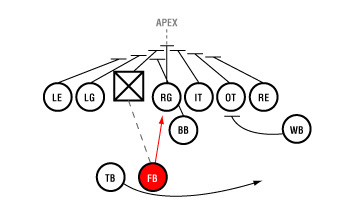
Snap to the fullback with the wingback in motion, the tailback spins counter-clockwise fakes handoff to the motioning wingback and both backs dip inside shoulder and run hard “rocking the cradle” to opposite edges, while the blocking back pushes on back of center.

This is a big back breaker play. Same as Base Wedge except at the snap the blocking back turns and faces opposite goal line, he crouches low and puts both arms in an underhand scoop type position. As the fullback runs by he hands the football to the blocking back who gains depth and runs a sweep around the right end. The tailback runs right, just like regular wedge and takes out the cornerback. The wingback seals the end inside, everyone else wedge blocks. This play is so much easier and safer than the buck lateral series and takes no time at all to put in. It is a killer.
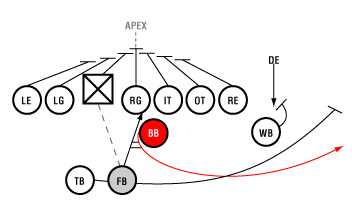
We ran this in 2003 and went 15-20 for 9 touchdowns. We averaged over 20 yards per attempt. Same play as above except the fullback looks backside after he hands to the blocking back. The tailback takes the right defensive end, the wingback takes an angle inside in order to block the outside linebacker, but at the last second before impact, steps to outside corner pattern. This gets him away from the corner and behind him. Then we just tell him to run to the corner, away from the safety. Usually there is no one even close. You can put your right end into a delay into the flat, but you only really need one receiver. Have your blocking back take four steps getting depth and some width, step and throw. It is about a 15-yard pattern.
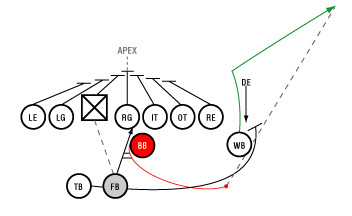
Same as Buck Wedge except we have the fullback keep and run wedge. The blocking back turns and fakes running sweep. Great play if you run the Buck Wedge a few times and this play takes no time to put in. It is a free play, if you will.
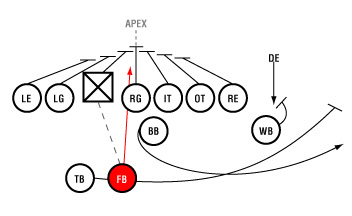
We run several and they are big plays for us. They almost look like draw plays because everyone runs by the ball carrier. We do the traditional fullback full spin blocking back wedge. We also fake our tailback sweep pass with the wingback going on a corner route with his hand raised and everyone following him. Meanwhile the tailback has his arm back and shoulder shielding the fact that does not have ball. The fullback fakes sweep.

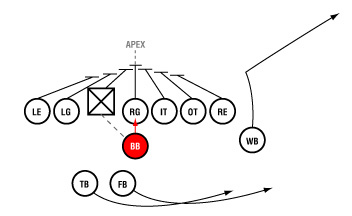
Our other blocking back wedge play is where both our fullback and tailback dive like there was a bad snap. Everyone else wedges with our wingback going on another fake corner route.

Remember your blocking back has to move over so he is right behind the right guard, even a hair more towards the center, and maybe a half step back of his normal depth. The center needs to just lob it low at an angle and let the blocking back catch it. It sounds much more difficult than it really is.
You guys are really missing out if you do not run both the fullback and blocking back wedges or the big hitting Buck Wedge series.
Dave Cisar
President
Screaming Eagles
Omaha, Nebraska
www.screamingeaglefootball.com
Inter-Library Loan
December 6th, 2004
First, I would like to say I really enjoy the Direct Snap Site and the articles have been outstanding. This article will be a bit different since it is not about X’s and O’s or the history of our great offense. However, for the new coach to this offense or plain old football fanatic like me this will open a new research door.
My first year as a head coach I ran a Wyatt style double wing. We were in a league from San Diego County and during that year we had the big fires that made the national news. Since the air was so bad all practices and games were cancelled. I had just received my Calande single wing video. I planned on watching after the season. Since there was no practice or game to prepare for I decided to watch it, after seeing how similar it was to what we were doing with the double wing I realized this was the offense we needed to run before the end of the season. We did run it our last game with a 6 hours practice but that’s another story. After that game I became a diehard single wing guy.
I would go to the Delphi Single Wing Forum and hear all these guys talking about books by Aldrich, Keuffel, and Caldwell. I wanted to read these books so I could have a better knowledge of the single wing. I used the Internet to try and find a way to buy the books but I always ran into a dead-end. I would always see posts from Wade at the Delphi Youth Football Coaches Forum site talking about something called an inter-library loan. It sounded real difficult but I HAD TO READ THOSE BOOKS! Finally I said what the hell decided to try it.
The first book I decided to get was Coach Aldrich’s “Single Wing Offense with the Spinning Fullback”. I got the basic information from Russell Farley’s Football Booklist and went to the library. There is a link to the booklist at this site. Here is all you need:
Title: Single Wing Offense with the Spinning Fullback
Author: John F. Aldrich
Year Published: 1983
Publisher: Iowa State University Press
ISBN: 0-8138-1643-2
Sometimes you won’t be able to find the ISBN for the book you want. It helps if you have it but I’ve always been able to get the book I’ve requested without the ISBN.
I went to the library information desk and asked how to use this service. I was given a simple form to fill out. Like this:
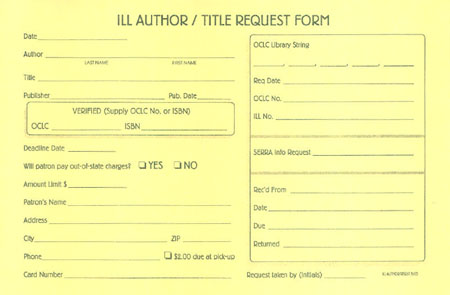
There was a part on the form asking how much I was willing to pay for shipping if the sending library required it. I put $10.00. I’ve never had to pay any shipping. Usually I’ve had to pay a $2.50 service fee. However for out of state books it could cost up to $20.00 in shipping cost. Good reason to copy the book since it’s about the price of a book today.
In less than 2 weeks I received my notice that the book was in. I went to the library and there it was — Coach Aldrich’s “Single Wing Offense with the Spinning Fullback”. When I signed out for the book I noticed there was a wrapper around the book notifying me that it had to be returned by a certain date and couldn’t be renewed. I point this out because now anytime I receive my notice I rush to the library because the loan period is already in effect even though I haven’t checked out the book.
I’ve ordered Caldwell’s “Modern Single Wing”, and Tierney and Gray’s “The New Double Wing Attack” and Coach Aldrich’s book a second time. I just ordered a Fritz Crisler book and received it in less than 10 days.
The basic book information you would need to order a book you can get from Russell Farley’s booklist, another good source to find basic book information are the bibliographies at the end of John Reed’s Youth football books.
I want to thank Adam for allowing me to post this article so the coaches who want to check this offense out can find the information on how to properly install the single wing offense.
Tom Davis
San Marcos Pop Warner
[email protected]